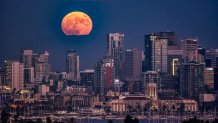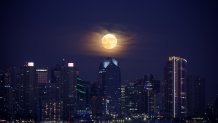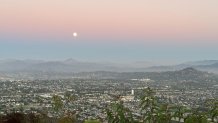San Diego star-gazers did not disappoint in capturing a rare phenomenon that won't happen again until 2037.
A full moon, supermoon and blue moon all converged together Wednesday into the bright nighttime sky and San Diegans were there to capture it. Take a look at their photos below.


Get top local stories in San Diego delivered to you every morning. Sign up for NBC San Diego's News Headlines newsletter.



The moon rose Wednesday evening at 7:29 p.m. and reached its highest point in the sky at 12:14 a.m. with a whopping 99% illumination.
Local
What is a blue moon?
As with the monikers of many astronomical phenomena, the moon will not actually look blue. A "blue moon" is the term for the second full moon in a month, which usually only has a single full moon.
What is a supermoon?
The moon is constantly moving in an oval shape around the Earth. So sometimes it's closer to the Earth and sometimes it's farther away, according to NASA.
A supermoon occurs when the moon is full while at the same time reaching at or near its closest point to Earth, specifically within 90% of the closest it can be to our planet, NASA says.
The full moon will be closer to us earthlings than usual, making it appear brighter and more "super" than a regular full moon.
A rare trifecta of natural phenomena
You'll have to wait until January and March 2037 for the next super blue moons, which will occur just after each other!
The last time two full supermoons happened during the same month was in 2018.
About 25% of all full moons are supermoons, but only about 3% of full moons are blue moons, NASA says. The time in between super blue moons is rather irregular, with 10 years the average and 20 years the maximum.
August's full moon is traditionally known as the sturgeon moon, according to the Old Farmers' Almanac. Hundreds of years ago, the full moon would illuminate the once-abundant sturgeon fish species in the Great Lakes during August.
Recent supermoon encounters
You might remember the year's first supermoon happened in July. The fourth and last time to catch a supermoon this year will be in September, AP says. However, this August supermoon was closer to us than those.
If you're mesmerized by the moon, NASA has a daily moon guide here, which is an interactive map for observing the moon each day of the year.



